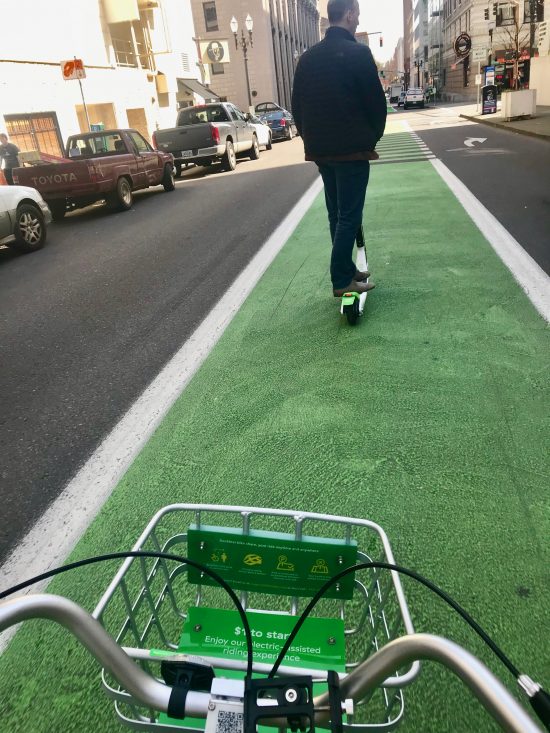
(Photos: J. Maus/BikePortland)
Here’s my predication: It’s not a matter of if Portland will get dockless bikes, it’s a matter of when.
On Monday we revealed dockless bike share start-up LimeBike is hiring a full-time staff person to manage their fleet in Portland. In response to that story the City of Portland confirmed with us they’ve been in contact several bike dockless bike share providers. Bureau of Transportation spokesperson Dylan Rivera shared via email, “We are developing a timeframe and process for the permits needed to provide private bike share service.” This acknowledgment follows a field trip to Seattle earlier this year where PBOT bike share staff tested dockless systems.
Just yesterday, LimeBike Chief Program Officer Scott Kubly (a former director of the Seattle Department of Transportation and former colleague of PBOT Director Leah Treat) and LimeBike’s Portland-based Regional General Manager Jason Wilde were in town. They had one of their electric-assist bikes and an electric scooter along with them. I met them briefly downtown to learn more about the company and get a chance to test ride both products.
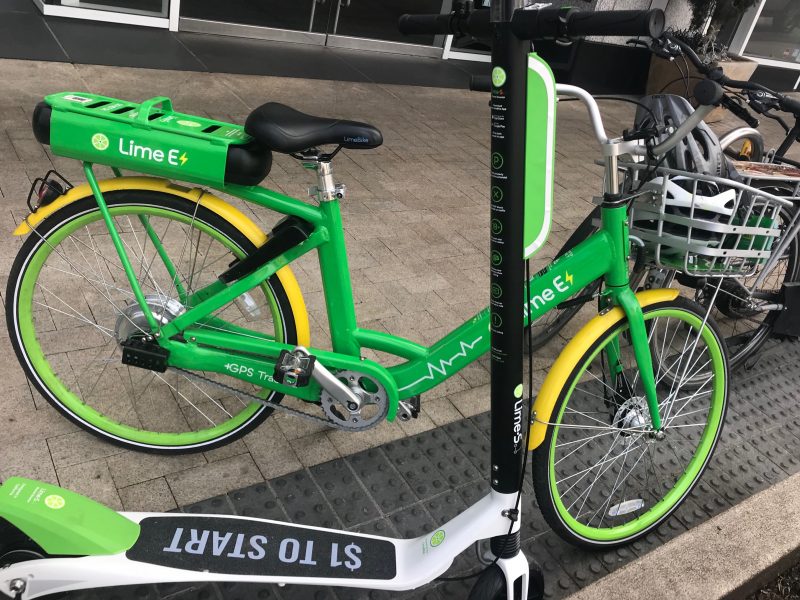
The first thing I grabbed was the scooter. Dockless, e-scooters have already hit the streets of San Francisco and a few other cities. They’re attractive to operators because they’re cheaper and easier to deploy — and more importantly — most cities don’t have any specific regulations that prohibit them (although San Francisco is talking tough).
The scooters would work just like the bikes. With the app on your phone you walk up to the scooter you want, scan the code, wait for the beep, and off you go. It’s $1 unlock and just 15 cents per minute once you get going.
I loved riding the scooter! My only reference were the scooters my kids have used over the years, so the first thing I noticed was how beefy it was. The stanchion that holds the bar, the platform to stand on, and the wheels themselves felt plenty stout (and I’m 6-foot 2-inches and about 175 pounds). There was a hand-brake on the left and a little throttle for my thumb on the right. All I had to do to get going was to push-forward gently with my leg.
The feeling was like a hybrid of biking and walking. I felt unencumbered by a large mechanism of metal tubes, yet I was in the road with other vehicles (riding on sidewalks downtown is illegal). Hitting large bumps and crossing light rail gaps was a bit unnerving at first; but fine once I got used to it. I liked how nimble the scooter felt, and how easy I could transition between being a vehicle in the road with car users, and then morph into more of a walker when I wanted to. I rolled over to the carfree Ankeny Alley and was able to ride it at walking speed in a crowded environment without people jumping out of the way or giving me the stink-eye.
Top speed was 15 mph (maximum allowed under Oregon law), which is all you need downtown (signals are set for 12 mph), until you get a jerk behind you who think you’re using a toy — but that’s something I’m used to as someone who rides a bike traffic all the time. Speaking of which, for people not used to biking in traffic, these scooters will take some getting used to. I would suspect a bit of a learning curve and a few tumbles for sure. One thing I don’t like about the scooter is I couldn’t signal my turns because I didn’t feel comfortable enough to take a hand off the bars. That’s really dangerous in a crowded street environment. They really need blinkers. (Or I suppose I could have tried kicking one leg out either side.)
Once I got the hang of it, I was comfortable weaving around busy downtown Portland traffic. And it was really fun and easy!
Advertisement
Overall I’m very intrigued about the potential these scooters have for being an affordable, efficient, and safe way to get around. You probably wouldn’t commute or ride a few miles with these. The scooters would be perfect for moving within neighborhoods and commercial districts, or as a last-few-blocks solution from your transit stop to your destination.
And yes, electric scooters are allowed in bike lanes and paths in Oregon. However, according to this handy guide from the Oregon DMV, you cannot ride them in crosswalks. And unlike with bicycles, adults are required by law to wear helmets while using an electric scooter.
I also rode LimeBike’s “Lime-E” electric bike. It’s a basic city bike with everything you need including a bell, lights, and a basket. The first thing I noticed when I got on is that you don’t have to shift. Just start pedaling and the motor kicks in, with the gears changing automatically as you ride. The torque is much stronger at slow speeds, which was nice for jumping from a stop. But that meant I felt less power as I pedaled more. Overall it seemed like a fine bike. It’s not as stout or tight as our wonderful Biketown bikes (doesn’t look as cool either in my opinion), and I’d have to spend more time on it to really give it a full review.
E-bikes could really take a big bite out of Biketown. It’s so nice to have a free boost of power that can make hills a breeze and give someone an extra dose of confidence and power when they need it. For many people, having access to an affordable e-bike could be that game-changing factor that allows them to give cycling a try (and ultimately stop driving so much).
As for when we might see dockless e-bikes and e-scooters in Portland. Officially, everyone’s tight-lipped. But my personal hunch is that once PBOT finds a regulatory/political situation they’re comfortable with, they’ll put out a public invite to dockless vendors. Then they could host some sort of pop-up demonstration (like at Sunday Parkways for instance) and/or a pilot project to see how it goes.
The trouble is, dockless only works when a sufficiently sized area is saturated with bikes (Seattle has 10 times as many bike share bikes on their streets as we do). A limited trial might not demonstrate their true potential, but on the flipside, if too many hit the street and the parking clutter hysteria takes root, PBOT might get cold feet.
Hopefully we figure out a way to try this that gives this new technology a fair shake, without over-regulating it to death.
PBOT was famously slow to get a bike share system. It took us nine years to get from planning to signing a deal with Nike. They can’t do that with dockless. Things are moving fast and if Portland wants to reap the immense benefits of highly accessible, inexpensive, healthy competitor to private car use — the City needs to make this happen sooner rather than later.
And as host city of the just-announced North American Bike Share Association/Better Bike Share Partnership annual conference, Portland won’t want to look outdated.
Stay tuned.
— Jonathan Maus: (503) 706-8804, @jonathan_maus on Twitter and jonathan@bikeportland.org
Never miss a story. Sign-up for the daily BP Headlines email.
BikePortland needs your support.



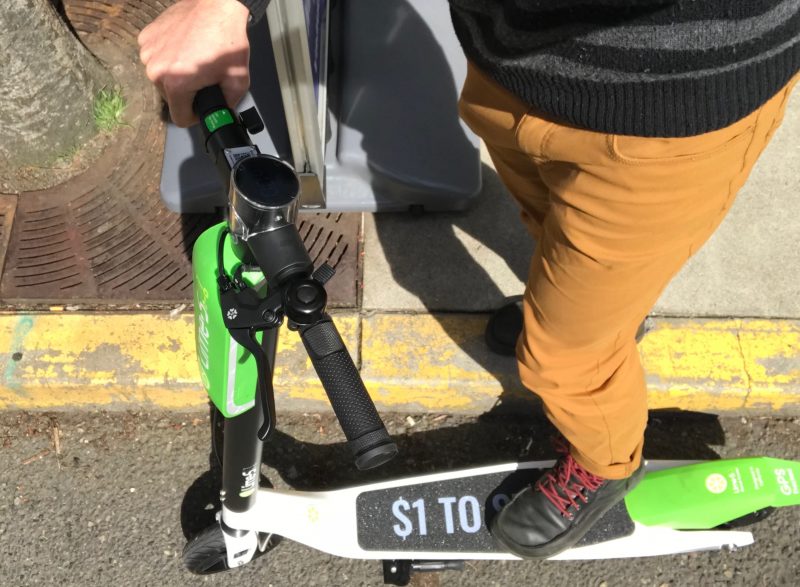
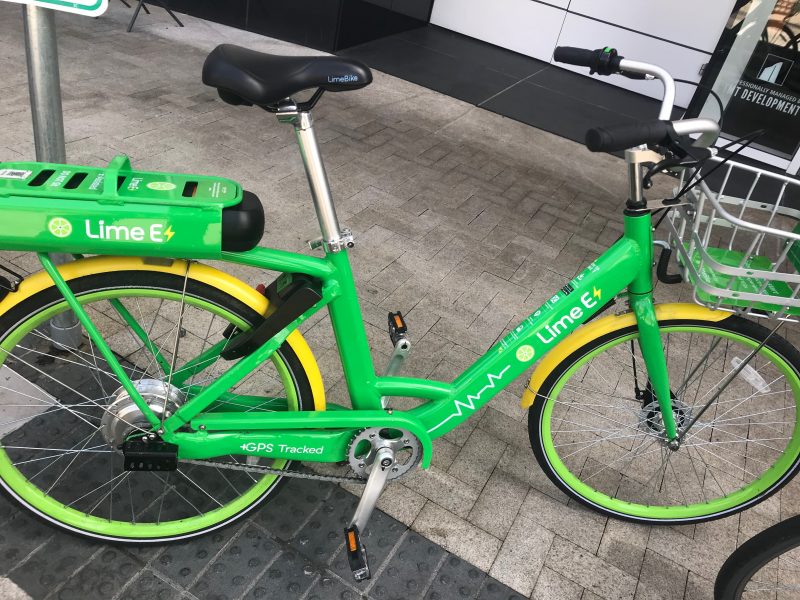
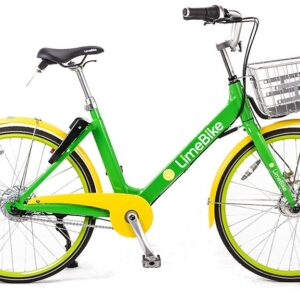
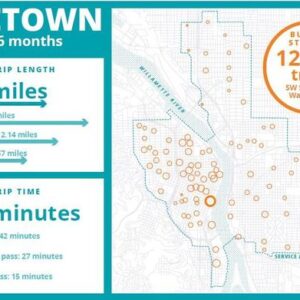
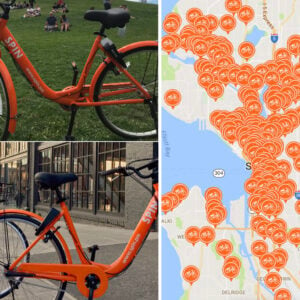

Thanks for reading.
BikePortland has served this community with independent community journalism since 2005. We rely on subscriptions from readers like you to survive. Your financial support is vital in keeping this valuable resource alive and well.
Please subscribe today to strengthen and expand our work.
Potential Lime Bike/Scooter game-changing elements:
– The psychological impact of the presence of road users on scooters that at a glance appear even *more* vulnerable than bike riders (more pressure for physically-separated bike facilities)
– Electric motors that overcome a lot of “I can’t cycle for this trip because…” arguments
– Bikes/scooters in much greater density than Biketown (never have to look far for a bike)
– Bikes/scooters in much wider area than Biketown (never have to worry about destinations outside the usage zone)
– Bikes/scooters at every transit stop (actual reliable last mile solution)
Best-case scenario: the doomsayers are correct and we end up with bikes/scooters strewn EVERYWHERE. Then we can go to PBOT and request that the 20′ before intersections (where it’s illegal by state law to park a motor vehicle, but PBOT allows it anyway) be dedicated dockless bike/scooter parking zones. Slap down some paint like Seattle did, and we’ve hit two birds with one stone.
interesting stuff J.E.
another difference with scooters is they don’t have all the cultural baggage biking has. I think a big barrier to getting new people onto bikes in Portland – because we have such a strong identity and culture around biking in this town – is that people think, “I’m not one of those cyclists.” That won’t exist with a scooter. Of course it’s also a scooter – which have their own image problems too i guess.
ORS 811.550(17)
Do it PBOT! It’s the law already.
This is an awesome comment. You’re 100% right. Scooters have the potential to be *extremely cool* —especially among millennial who feels they missed out on a proper childhood. Bring ’em on.
Pretty interesting…so does the e-scooter have a headlight or rear reflector for night time use? (Or operational rules limited them to daylight use only?)
Thanks John, for your sharper eyes!
$0.15 per minute works out to $9.00 per hour, seems a bit steep to me…
I’d be surprised though if many folks ride for an hour. Maybe a better way to frame it would be you can ride on a dollar for ~7 minutes (after $1 unlock). But I agree, even if your “commute” is only 30 minutes a day total that’s still as expensive as a Trimet day pass. Would be interesting if they roll out a regular user plan like biketown.
Compared to Biketown:
Single ride works out to $5 an hour
Day pass is $4 and hour if you use it the full 180 minutes
Membership is $144 annual commitment for up to $0.27 /hr efficiency.
Any overtime on biketown is 0.10 a minute.
Great writeup. I’m curious to see how EVs perform here and elsewhere. Great for trips here and there, but they cost several times as much while not going much faster if at all (15 mph limit), hills excepted.
That said, docked bikeshares have thrived on a model that charged occasional users far more, so it’s possible. And it could be a great gateway to people who don’t bike regularly, buying their own ebike/scooter.
JUMP has the best electric bikeshare by far – $2 for half an hour, 19mph speed limit. Limebike is $4 for half an hour ($2 for 10 min, $3 for 20 min).
They go fast enough now.
Interesting that this is coming up now. I phoned PBOT two weeks ago about the e-skateboards that I have been seeing around. I had a nice interview with a fellow on the Springwater and he mentioned that his made it up to 30 MPH! This conversation happened while we were both going about 22mph. All that to say is, I’d like to see some sort of classification system for each style of transportation with a set of independent rules so that we can all be clear of what is acceptable. Why? Because I have seen e-boards do things have been unsafe to themselves and others when blowing reds downtown.
Jonathan, what’s the stopping time on the scooter?
I think there’s an illusion of danger involved here. A person on a e-skateboard or e-scooter looks like they are traveling faster than they are because they “clear” the sight-line they obstruct faster than a longer vehicle does. It’s the reason a stretch limo looks to be moving slower than a “smart” car when they are both going the same speed. There’s also the social training issue that has made us comfortable with heavy, deadly machines traveling at unsafe speeds but a human on a fast skateboard is uncomfortable to us because it’s not something we are yet accustomed to.
Personally, I would be much happier sharing the road with an army of e-bikes, e-scooters and e-skateboards going 30 mph than I am with the same number of cars at any speed. The potential momentum transfers available if things go south is so much lower that the probability of a serious injury or death is too small for me to fret over. Add in the much smaller size and greater maneuverability of these things, and my worries are nonexistent.
Interesting. Your limo/smart car example explains why the UP trains that block the crossing at SE 12th often appear not to be moving at all.
That illusion makes them easier to run into.
No you would’nt. How many hours you got in a peloton speed racer?
I would, if people were spaced appropriately for street travel, rather than a bike race. Nothing in B C’s comment implies a desire for peloton-like drafting positions and tight spacing. It would be remarkable to see what might happen if everybody rode bikes/scooters for a day and weren’t crowded into a single half-width traffic lane. And no, you can’t use Bridge Pedal or any other organized ride along a pre-determined route as an example of how crowded it would be.
Yep. E-bikes need regulation too… AND enforcement. It’s only a matter of time before a careless E-bike user causes a serious injury of a pedestrian or cyclist. The amount of unsafe passing, stop sign / light blowing etc I’ve witnessed by E-bike users is huge. They’re approaching moped and even motorcycle speeds, so why don’t they require a license? And let’s slap a punitive and poorly-conceived sales tax on ’em while we’re at it.
They are a vehicle with a motor. A motor vehicle.
Why are they allowed on “No Motor Vehicle” paths?
Isn’t this smarmy “ignorance” just denial ?
Another classic rich guys trick ?
For anyone interested, here is a fantastic article that I believe summarizes some key considerations for dockless bikeshare extremely well.
https://www.enotrans.org/article/integrating-dockless-bikeshare/
I think dockless is fantastic, and I’m excited to see that Limebike may be coming to Portland! I live in Sellwood, out of the service area, and am a 15 minute walk from a MAX station in either direction. I could see myself using transit/bike/scooter share a lot if it served that area.
But I think that equity and sustainability for these dockless companies is absolutely something that needs to be part of whatever happens. I think data sharing should 100% be required in some way. It should be shared with PBOT at a minimum, and ideally be available to others.
I worry that venture capital bike share will kill public biketown bike share…
Umm… biketown is propped up by one of the largest corporations in he world. If it dies it doesn’t deserve to live.
Plus with competition, they have every incentive to improve
That is a naive statement.
Biketown is being funded by Nike’s marketing budget, the amount that Nike or any other company will spend on sponsoring a bikeshare is not open-ended. Biketown’s long term operation depends on it making enough revenue to keep the sponsorship need within the planned limits.
VC funded for-profit bikeshare is being propped up by hundreds of millions of dollars of investor capital. Their strategy is to throw money and bikes at dozens of cities, take market share, drive everyone else out of business, then figure out how to make a profit.
They won’t make a profit on $1/hour rental fees at the rides/bike/day they are achieving in Seattle. They will need to raise prices, sell customer data (location, habits, etc), sell a heck of a lot of advertising, or get cities to subsidize them – and because they are for profit VC funded companies, they can’t settle for breaking even, they need to become really, really profitable.
Think of Uber – they can drive others out of business because they are basically giving away billions in investor money, but they haven’t figured out they are going to stay in business themselves after the investors get tired of throwing good money after bad.
I honestly don’t understand why the rush to invite Limebike etc into Portland. Shouldn’t we first see how it works out for Seattle, Dallas, etc? Cities that have no bikeshare, they can do this – it gives the cities a free way to say “look we have bikeshare” and they have nothing to lose. Cities who already have good public bikeshare – they are better off letting the for profit companies prove that they can actually provide a stable, long term service.
I say that as someone who has seen many startups make a splash, burn through their capital in a short time, and then disappear.
If you (we) are going to bet our bikeshare future on a for profit company, you are betting that the company is going to make the kind of profit their investors demand, so they will continue to provide that service. Have you done such a financial analysis and concluded Limebike is indeed very likely to become very profitable in Portland within a few years? Have the companies disclosed enough data to allow anyone to reach such a conclusion?
In the end, what I want for Portland is one or more sustainable bikeshare system(s). What I don’t want is a couple years of intense competition between systems that insures that they all fail.
A sustainable business is one that is not dependent on one primary advertiser or, if it is, it has other advertisers lined up for that role. Are there other advertisers lined up to sponsor Biketown at the same level should Nike exit?
I don’t see value in introducing another system at this time unless it covers areas outside of Biketown. What am I missing?
Full disclosure, despite being an owner of 4 bicycles, I still find myself using Biketown several times a year.
Why is there a little white Ferrari 488 in the basket in second picture?
I look forward to all incarnations of e-bikes, e-scooters and even the e-skateboards no matter how they get out on the road. I’m cautiously optimistic that they will help us get past that barrier of critical mass and get non-car transportation into the realm of “normal” in people’s minds.
As an added bonus, if there are a large number of e-bikes being used, it changes the game for our horrid standards for bike infrastructure. Currently, bike infrastructure is designed for very low speeds and we allow lots of dangerous solid objects to be placed right at the edge of narrow pathways. If many people are routinely riding at 20 mph, it puts pressure on transportation departments to improve their standards. We might even move away from our current unwritten assumptions that bikes replace walking to a better reality in which bikes replace cars. Of course this means that pretty much all the separated bike infrastructure currently built and planned will be obsolete, some of it before it is even constructed.
This is an interesting point, and brings to mind also the lack of concern about debris, grates and deep manhole covers in bike lanes. On the other hand, I’d prefer to see all modes of traffic moving at >20 mph take over space currently dedicated to cars instead of having to chip off scant bike/ped space for them. There really does need to be dedicated space in cities for people moving at human (non-motorized) speed – in fact, there needs to be more of it than there is now – AND space should be taken away from cars to accommodate scooters, segways, ebikes, motorized skateboards, etc. With proper encouragement, these modes could eventually get us to a place where car travel within a city is considered primitive, barbaric and (at the very least) rude.
The WSJ article you linked to didn’t even mention “parking clutter hysteria” (or any other kind of hysteria), and barely touched on the issue of clutter at all (though it was in the headline and in the caption of a photo). Perhaps you meant to link a different article?
What a set of screwy laws we have. Compare the motorized scooter to the bike and segway laws. Basically copy+paste+disdain. At least there’s a religious exemption, maybe if you believe in statistics, that’s enough. In practice, most of these laws are only useful as excuses for racial profiling. https://www.oregonlaws.org/ors/814.534
During my travels this week I had the opportunity to take two long rides on electric LimeBikes: a 21 mile ride near San Francisco Airport and a 25 mile ride in downtown Seattle and its eastern suburbs. Here’s a short review…
The electric boost of the e-LimeBike is helpful when accelerating from a stop and for going up moderate hills. I’ve rode a few standard LimeBikes and I found the electric version far more enjoyable. I was able to ride the electric LimeBike much further before the frustration of riding a heavy city bike set in. The motor helps the heavy bike feel more like a normal bike. Pulling away from a stoplight with traffic I felt confident with the boost helping me get the contraption moving. On average, I’d say the e-LimeBike requires about the same power input from the rider as a lightweight road bike. With some exceptions.. .
The e-LimeBike feels most comfortable and easy to pedal at speeds around 10-12 mph. At those speeds the electric assist seems to do most of the work. When I tried to pedal faster the bike felt like it had a parachute attached. I’m not sure if that’s because the generator kicks in or just because the bike weighs a ton. Holding a pace above 14 mph feels excessively strenuous. Riding slow feels effortless.
The e-LimeBike glides over moderate hills but struggles with steep grades. On hills with grades of 4% or less the boost made the bike feel easy to pedal, like my mom could do it. However, when things got even slightly steeper the electric motor wasn’t enough. Somewhere around 6% grade the e-LimeBike starts to feel like a brick. On a steep hill it’s at least twice as hard to pedal as my road bike, it’s a lot harder than pulling my kid on a trail-a-bike up Rocky Butte, not joking.
On my San Francisco ride I put the LimeBike through a climb torture test: I rode it up Guadeloupe Pass Parkway, a 650 foot climb on the north side of San Bruno Mountain. At the base of the climb I started off at a stoplight next to a lycra-clad, carbon-framed road-biker.
He immediately pulled away from me and got a good 100 yard lead. However, about halfway up I started to gain on him and eventually passed him. Then, about a 1/4 mile short of the summit, disaster, the battery died. The roadie passed me again. The e-LimeBike on a climb without a battery is awful. I was close to getting off and walking it up. Thankfully, on the long downhill the battery built up enough charge to get me back to the airport. When I had picked up the bike, the LimeBike app said it had 24 miles charge on it, I guess the app wasn’t counting on a long climb.
My ride in Seattle was more pleasant. The Seattle ride had twice as much climbing according to Ride With GPS than my San Francisco ride but it was rolling terrain rather than one long effort. With lots of little downhills the battery maintained its charge. I really enjoyed riding the e-LimeBike around Seattle. The bike felt comfortable and borderline fun. However there were still several hills that were too steep for the bike. A novice or out of shape rider wouldn’t have made it. Also, when pedaling upwind across one of Seattle’s long bridges, the bike felt excessively difficult to pedal, like the generator was on when I was already working hard. Then, going back the other way with the wind at my back, the electric boost kicked in when I didn’t need it. I flew across that bridge. It was fun but I would’ve preferred the boost while going into the wind.
Overall I love LimeBike. I’m an airline pilot and I’m away from home half the week. These bikes have completely changed my overnights. After 19 years of being limited by how far I can walk, dockless bikes are a miracle. I want to see them in every city.
Yeah you start going up a climb of any length on an e-bike and it seems you loose another mile of range every 15 to 25 seconds. Of course you start going downhill and you start gaining range like crazy, even on bikes that don’t generate power to recharge the battery. It can sort of drive you nuts watching the range left in the battery going over a lot of rolling type climbs.
So it’s predicting miles left if you continue doing what you did during the last measuring internal, and that internal must be very short.
I can’t speak for all ebike systems but Bosch calculates range based on the past two miles. This leads to a lot of variance depending on if you’re gaining, losing, or maintaining elevation.
Did they explain how the bikes will get recharged? Or discuss how much the bikes cost, or if the rental fee for an ebike will be different than for a standard bike?
We have the LimeBike e-bikes where I live currently (San Diego). The e-bikes and scooters have the same pricing: $1 to unlock and 15 cents/minute of use.
The e-bikes and scooters are picked up nightly for recharging/rebalancing and are redistributed in the wee hours of the morning for those who have early commutes. I’m not sure if all of the bikes are picked up or only those that need charging.
I found the scooter to be a lot of fun and e-bikes to be really useful, but the e-bike and regular bike ride like they’re somewhat lifeless and unresponsive. They use an airless bike tire that is fairly squishy. I noticed that the front-end of their regular bikes is quite a bit heavier than the rear; I’m not sure if that also contributes to the ride quality.
Picking up a bike at night, trucking it back to a central shop, recharging it overnight, and trucking it back out to the street in the morning is a costly thing to do.
It’s a moped. Have fun. I do not look forward to some distracted device devotee heading towards me at 25mph. But easier is better, right?
The worst thing about a moped is the dirty 2-stroke engine. So, upgrade. I’d have to see how the charging issues are dealt with. Can you see the charge level before you unlock? And it sounds like the Limebike brain is a kludge.
Better than a car?
No, it’s pedal assist, and fairly low-geared I’m their only gear. It assists you less the faster you’re going, which isn’t very fast. They are nice in my hilly neighborhood in San Diego though
somebody needs to change the helmet law… deems silly that you can operate an electric bike at 20 MPH with no helmet but you need one to go 15 MPH on a scooter…
How do you forsee changing the helmet law ?
why is the max allowed speed only 15 MPH? especially when the max capable speed is 24 MPH?
you’d be riding your brakes downhill all the time to comply…
The whole section of laws on motor assisted scooters (ORS 814.510-536) are a little terrible. There are no exceptions for when a scooter operator can leave a bike lane, the speed limit is a little dumb; I’ve seen non-motorized skateboarders going faster than 15 downhill downtown, mandatory all-ages helmets for something no more dangerous than running—are these laws meant to apply to personal mobility scooters, or two-wheeled scooters?
Was in Seattle on Sunday for the baseball game, and found the Lime Bikes parked haphazardly in SoDo – left on corners, in the middle of sidewalks – doesn’t seem like a great addition.
http://komonews.com/news/local/seattle-bike-share-limebike-accuses-ofo-of-unfair-business-practices
Ofo has $3 billion of funding from Chinese companies, and is allegedly providing free rides in Seattle to drive competitors out of business. Spinbike has removed some bikes from Seattle. Limebike is still trying to compete.
This is what for-profit VC-backed bikeshare will bring to Portland. The companies will flood the city with bikes, try to drive each other out of business, including by not charging for rides. When the winner has driven the others out of business – including our public not-for-profit Biketown – they will exploit their monopoly position. Prices will go up, service will deteriorate, personal data and location will be sold, the city will be pressured to pay the company so that Portland can keep having bikeshare.
Seattle doesn’t appear to care about or understand this, since the city is not tracking revenue to assess if the private companies will be able to stay in business. Many commenters just think “cool, bikes everywhere and they are cheap / free”.
As I said above, don’t be so naive.
What’s this about the “gears changing” on the limebike? They look to be a bafang motor, but I haven’t heard of any of those with multiple internal gears.
I used one to grab lunch today (so I did not have to ride up the hill twice) and, wow, was it slow. There was only one gear and it was so low that I really struggled to keep the electric assist engaged. I don’t think I would ever use one of these for transportation.
Also, lime charged me for the ride despite my precisely following OHSU’s instructions (including verifying my OHSU email).
I wonder whether they’ve tried out the “Lime E” in London…